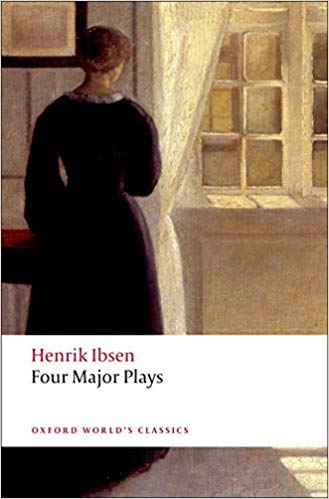
In preparation for my trip to Norway, I tried reading some Norwegian authors. I wrote about Hamsun first, but the first author I read was Ibsen. I started with Four Major Plays.
Ibsen
Henrik Johan Ibsen (1828 – 1906) was a Norwegian playwright, theater director, and poet. He was, a founder of modernism and one of the most influential playwrights of his time. He is still, apparently, one of the most performed playwrights in the world. So it’s a little embarrassing that my knowledge of him didn’t extend past name recognition. To rectify the situation, I checked out Four Major Plays from the library.
Four Major Plays
According to the introduction, A Doll’s House was the first major play, and it’s heroine so scandalized Europe that Ibsen had no choice but write the other three. The four plays supposedly follow some sort of progression in response to the public outcry over his “monstrous” heroine in A Doll’s House. I didn’t have quite such a linear experience.
A Doll’s House
I still can’t believe A Doll’s House was written in 1879, because it has a powerfully contemporary sensibility. Regardless of history, it might be one of the best pieces of literature I’ve ever read. The frothy trophy wife and condescending husband had me nearly tossing the book aside for the first two thirds of the story.
Then, at the precise moment when I thought to myself, “Well, I’ve had just about enough,” so does his heroine. With that twist, I realized that every impression, every emotional response that I had to the characters so far was as carefully scripted by Ibsen as the dialogue.
Ibsen’s perfectly crafted scenario spoon fed to his unsuspecting audience (in aikido we would call it backleading) his damning judgement against a society determined to infantilize half of its population.
Nora’s final speech and actions were the only possible response I could imagine for the situation. Anything else and I would have thrown the book across the room. The fact that Ibsen’s Victorian audience was outraged just goes to show how far ahead of his time Ibsen really was. Nora is my hero. I want to be Ibsen when I grow up.
Ghosts
In contrast, I keep forgetting about Ghosts. I say, “I read four plays by Ibsen,” and then can only name three of them. This 1882 play is in some ways an extension of the theme, in that it does explore a mother’s duty.
Ibsen is still calling out bourgeois hypocrisy, and we are still made to sympathize with a woman who initially make sacrifices to maintain appearances and then is condemned for making larger sacrifices for their own values. In 1881’s Ghosts, the stakes are higher, and the outcome less certain.
But the situation feels contrived, the characters are too stiff. The sordid details were so heavily glossed over that it was hard to tell what really happened – did the son have inherited syphilis or a metaphor? I just couldn’t connect with the story enough to care if Mrs. Alving did the horrible thing implied at the end.
Hedda Gabler
Noble Nora was condemned as a monster in 1879, but in 1891 Ibsen gave audiences a real monster in Hedda Gabler. I get that she was an intelligent woman with very little agency who felt trapped in a cul-de-sac for the rest of her life. She’s also the prototype for those physically attractive yet shallow and callous, destructive women that have no basis in reality but litter 20th century literature. There’s no excuse for fucking with people the way Hedda did and I’m glad she’s dead. Even though I hate the “suicide as female agency” trope.
The Master Builder
If the others didn’t do it, this 1892 play would prove Ibsen a modernist. It reminded me that I’m not a huge fan of modern theater. I spend the whole time thinking, “nobody talks like that.” Personally, my suspension of disbelief can handle iambic pentameter but I can’t handle perfect strangers spilling deepest secrets or foundational life philosophies right after ‘hello.’
I mean, yeah, The Master Builder is brilliant at exploring the psychological cost of success and how we erase ulterior motives from our personal narratives. But in the character Hilda he’s gone so far with his monster metaphor that she really doesn’t seem like a person at all. She’s just an apparition or a demonic messenger. The Master Builder felt like symbols were walking around stiffly in their character-coverings, and there wasn’t enough humanity left to make a story.
Four Major Plays
Author: Henrik Ibsen
Translated by James McFarlane and Jens Arup; with an introduction by James McFarlane
Originally published: 1998
Contents:
A Doll’s House (1879)
Ghosts (1881)
Hedda Gabler (1891)
The Master Builder (1892)



About the author